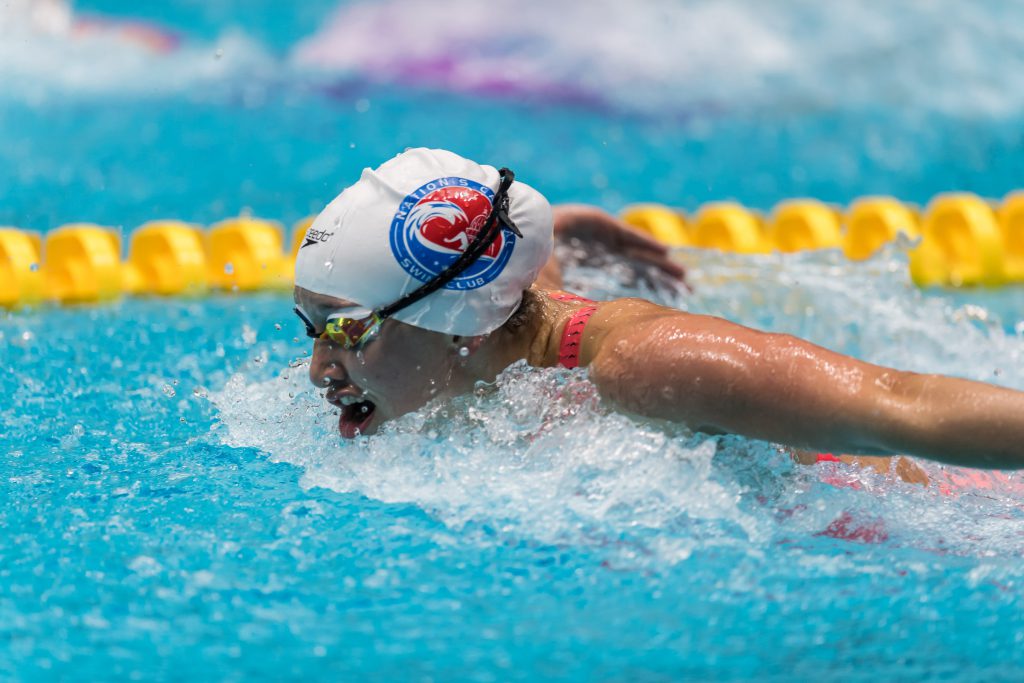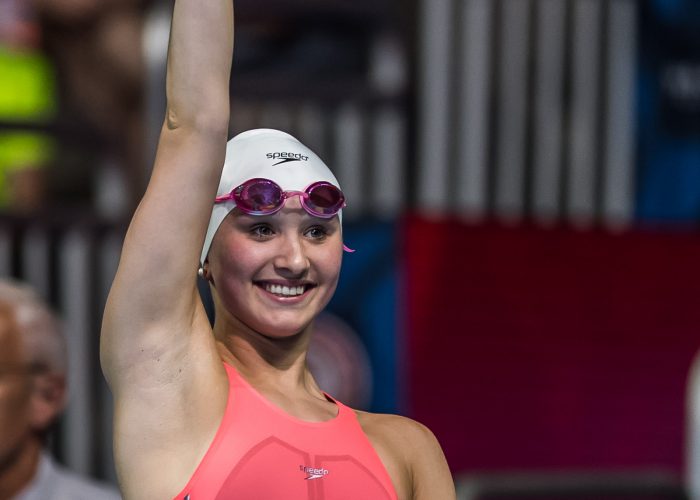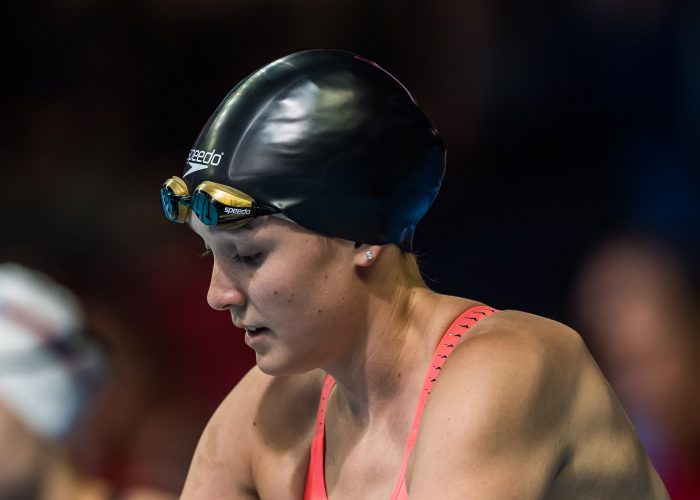Special Sets Presented by VASA: Getting Ready for Big December Meets

Special Sets is sponsored by VASA. Visit VASA.com for more information on our sponsor.
This month’s “Special Sets” feature profiles two 16-year-old girls—Cassidy Bayer and Ruby Martin—who finished third and fourth in the 200 meter butterfly at the 2016 U.S. Olympic Trials. It highlights sets they did in 2015 and will probably do in 2016 as they prep for their big December meets.
It’s been three months now since American swimmers shone in Rio and four months since more than 1,800 athletes vied for team spots at the U.S. Olympic Trials. Chances are you remember the names of those who represented the Red, White and Blue. But how about the names of the women who finished third and fourth in the women’s 200 meter butterfly at Trials? A little tougher, right?
Here’s a hint: they’re both 16 years old, extremely versatile, and they made the Junior Pan Pacs team that competed successfully in Hawaii in August.
The latest CollegeSwimming.com power statistics rank these girls second and 10th in the Class of 2018. Cassidy Bayer, a Nation’s Capital national team member coached by Jeff King, ranks second and has already made a bit of a name for herself. Ruby Martin of the Iowa Flyers in Iowa City (10th) is padding her resumé with each meet.
In 2013 at age 13, Bayer broke Mary T. Meagher’s 34-year-old 13-14 national age group record (1:56.38) in the 200 yard fly by going 1:56.01. And at one time, the former national junior team member also held 11-12 NAG records in the 50, 100 and 200 meter fly (28.23, tied with Dana Vollmer; 1:01.75; 2:15.02).
At Junior Pan Pacs, Bayer, a team captain, won the 200 fly in a meet record 2:08.48, finished fourth in the 100 fly (59.07) and swam a 59.14 butterfly leg on the “B” 4 x 100 medley relay that would have placed third in the championship final.
Martin, who credits coaches Richard Salhus and Robert Pinter with her training and success, went to Omaha with eight Olympic Trials cuts—more than the rest of the Hawkeye State combined. At the time, she held 92 Iowa Flyer long course and short course team records and 40 Iowa state records. At the end of August, she was the top-ranked swimmer in Iowa in 18 long course and short course events. In Hawaii, Martin finished fourth in the 200 fly in 2:12.99 after taking a big gulp at the first turn, won the “B” final in the 100 fly in :59.81 and led off the heat-winning “B” 4 x 200 free relay in 2:02.44.
Now with the short course season under way, each young woman is focused on the task at hand, which is to perform well at holiday meets, post improved times and, perhaps, impress some college coaches looking for immediate NCAA scorers.
Following are workouts each swimmer did a year ago in November and December and will probably be doing this year in preparation for their major pre-Christmas meets.
Special Sets Sponsored by VASA
CASSIDY BAYER

Photo Courtesy: Peter H. Bick
“Following is what we will be doing up until Thanksgiving,” says Coach King. “Afterward, we will bring the distance down, doing more quality repeats—oftentimes with less rest. For example: three 50 flys on 30 seconds. The first two are done, no problem; the third hurts a lot.”
Then Bayer will do a 1,000 kick for time. Last year without fins, she recorded a 13:47 followed by 25-50-75-100-125-150-175 fly.
“I take splits on a 200 for time, which she did in in 2:04,” says King. “The third 50, she did a 32. On this one, she had a great finish. A majority of the time, we go on rest intervals of 15 to 20 seconds.”
Next, Bayer swims three cycles of:
• 100 (75 free-25 fly) on 1:30
75 (50 free-25 fly) on 1:15
50 (25 free-25 fly) on 1:00
25 fly on :45
• Repeat substituting back for free on 1:25/1:10/:55/:40
• Repeat substituting breast for back on 1:20/1:05/:50/:35
“So, it is three rounds always ending in a 25 perfect fly. Fun,” he says. “For an entire week, we do two 200s on five minutes somewhere during the workout. On these, our goal with fins is sub-1:50; and without fins, 1:57. The first
one is swum working on technique (i.e., walls, underwaters, etc.) The second one is always for time. The goal is to keep the first two 50s close and have all 50s under 33 seconds. Cassidy does a lot here with tempo (1.2 seconds).
“Monday, Wednesday and Fridays, Cassidy does a five 100 flys all-out on five minutes. She has her choice of short or long fins for (the first three), and then no fins for (the fourth and fifth 100 flys)…OR no fins for one-to-three and then fins. The goal time with fins is :50; without fins, :56.”
General observations from Coach King:
• “I insist she keep her head down on all finishes.”
• “Cassidy has pretty bad asthma, so breath control is difficult. We are evolving her
stroke specifically to accommodate how she breathes.”
• “She also does tether resistant swimming (14 strokes-12-10-8-6-4-2).”
• “We have begun parachutes—mostly doing 25s, but occasionally doing 50s.”
• “She enjoys drilling fly with free kick.”
• “Cassidy constantly tweaks her meet warm-up, writing it on her phone as a
reminder.”
Special Sets Sponsored by VASA
RUBY MARTIN

Photo Courtesy: Peter H. Bick
Following are the two sets done five weeks and three weeks out from Martin’s major December meet:
Five weeks out: SCY
• 2 x 50 (200 pace + :02) + 2 x 100 + 8 x 50
• 4 x 50 (200 pace + :01) + 2 x 100 + 6 x 50
• 6 x 50 (200 pace) + 2 x 100 + 4 x 50
• 8 x 50 (fastest average) + 2 x 100 + 2 x 50
“The first grouping of 50s are done fly on 50 seconds. The 100s are freestyle on 1:15 at a heart rate of 140 to 150 beats per minute. The second grouping of 50s are done dolphin kick, and I let her choose how she wants to do those on an interval of one minute,” says Coach Salhus. “In November 2015, she held the following with a stroke count of less than 15 to 16 on each one. We will try to improve that this year.”
• 2 x 50 = 30.2
• 4 x 50 = 29.8
• 6 x 50 = 28.6
• 8 x 50 = 28.2 to 28.6
Three weeks out: SCY
“We do this four times throughout the resting phase, and we drop a round as we move forward closer to the meet,” says Salhus. “The 100s are done at the second 100 of her 200 goal, but must be even-split or negative-split. It is easy for her to hold multiple 50s at her given pace, but we try to challenge her to extend it to the 100s. We use the term back-end speed (BES) to indicate that in the set.
“The following set was done three rounds with about 20 days left before the Speedo Short Course Junior Nationals.”
Three rounds of the following:
• 1 x 100 (BES + :04) @ 1:30 + 100 recovery @ 1:30
• 1 x 100 (BES +:02) @ 1:45 + 200 recovery @ 3:30
• 1 x 100 (BES or faster) @ 2:00 + 300 recovery @ 6:00
100 BES :04
• Round 1: 1:02 (:31/:31)
• Round 2: 1:02 (:30/:32)—“Not a good one!”
• Round 3: 1:01 (:30/:31)
100 BES :02
• Round 1: 1:00 (:29/:30)
• Round 2: 1:00 (:29/:30)
• Round 3: 1:01 (:31/:30)—“I asked her to be ‘lighter’ on the first 50 and be more
aggressive on the second 50.”
100 BES
• Round 1: :58 (:29/:29)
• Round 2: :59 (:29/:30)
• Round 3: :57.8 (:28.9/:29.0)—“A little fast for the second 100, but she got the
idea of how to approach the 100s through the set.”
About the Author:
Michael J. Stott is an ASCA Level 5 coach whose Collegiate School (Richmond, Va.) teams won nine state high school championships. He was named a 2017 recipient of NISCA’s Outstanding Service Award.
This article was originally published in the November 2016 issue of Swimming World Magazine.




